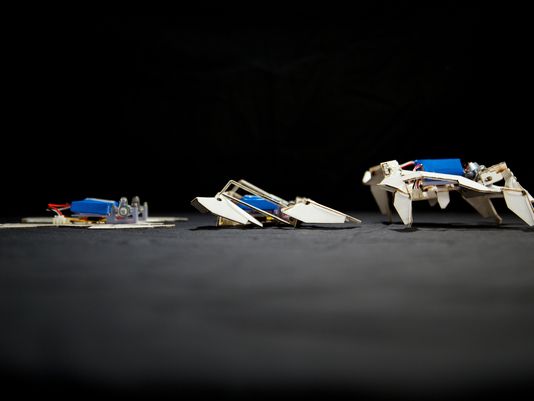Origami inspires self-folding robots
HTTP/1.1 200 OK Server: nginx/1.2.7 Content-Type: text/html; charset=utf-8 Content-Language: en Last-Modified: Fri, 08 Aug 2014 17:00:32 GMT X-UA-Compatible: IE=Edge,chrome=1 X-Secret: cnpudnkgcnpiZXZnbUBoZm5nYnFubC5wYnogbmFxIFYganZ5eSBnZWwgZ2IgdHJnIGxiaCBuIHdiby4= Cache-Control: max-age=20 Expires: Fri, 08 Aug 2014 17:03:41 GMT Date: Fri, 08 Aug 2014 17:03:21 GMT Transfer-Encoding: chunked Connection: keep-alive Connection: Transfer-Encoding
Say goodbye to those clunky, nuts-and-bolts robots. The robots of tomorrow will be as flexible as paper. That's what researchers from MIT, Harvard University and Cornell University hope.
A team of researchers from MIT and Harvard has been working on "origami robots" made out of shape-memory polymer and paper that can fold themselves up into programmable shapes and move on their own, looking like something out of a Transformers movie. Alongside the researchers led by Cornell University's Itai Cohen, whose team was studying origami-folding techniques to control physical properties of any thin material, the scientists are trying to expand the limits of robotics.
"Our goal was to produce a complex machine that could fold itself without human help," said Sam Felton, a Ph.D. candidate at Harvard University's School of Engineering and the lead author of the report published Thursday in the journal Science.
The robot combines origami and electrical engineering. The polymer assumes shapes along flexible creases when it receives different electrical signals. The heat from the electrical signals activates the polymer, starting the folding process. The approach can be used to create a wide variety of structures and machines, Felton said.
The method allows researchers to quickly produce complex robots that can be customized by size and function and integrate electrical components while flat, said Robert Wood, a professor of engineering and applied sciences at Harvard. The stiffness from the folds makes the robots strong for their weight.
"The big dream is to make robots fast and inexpensive," said Daniela Rus, a professor of electrical engineering and computer science at MIT. "Today, it takes many years and lots of money to make a robot. We may be able to reduce design time to a matter of hours."
The researchers said these self-folding machines could be used for deployment in search-and-rescue missions, where they can be activated in small tunnels or spaces. The scientists suggested their possible use for space exploration.
Cohen's team — which published its own report on origami techniques to create small transformers in Science — studied the origami pattern called Miura-ori, which can change the stiffness of a sheet of paper based only on crease pattern.
The researchers hope this can lead to atomic-scale machines that can be programmed based on folding patterns to snap back into place and perform mechanical functions.
"It's amazing that there are so many hidden scientific research problems buried in just a sheet of paper," Cohen said.
Read or Share this story: http://usat.ly/1shHnYp










